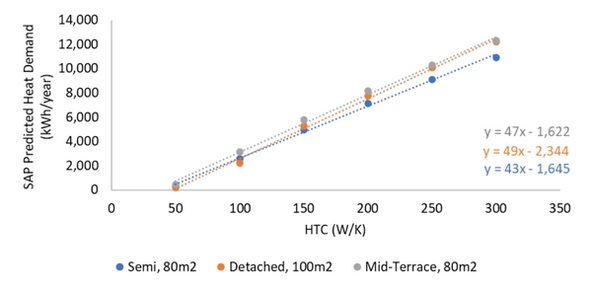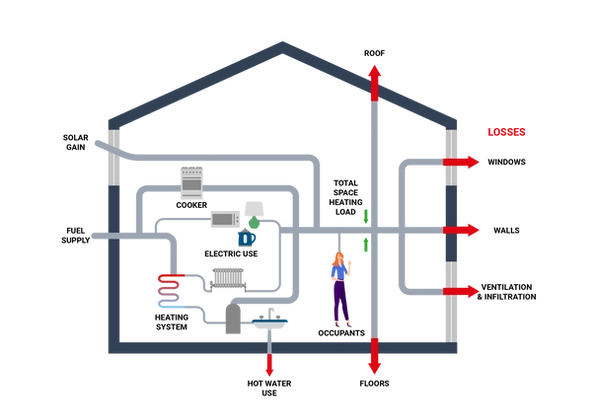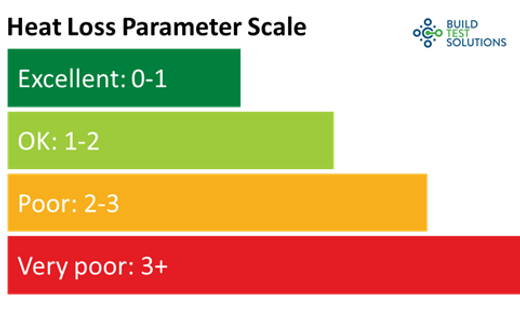Technical
The Relationship between Thermal Performance and Space Heat Demand
The thermal performance of a building is directly related to the amount of energy required to heat or cool it for the given internal and external conditions. Simply, if a building has good thermal performance (i.e. is well insulated) there is less heat loss and hence less energy required to keep it warm inside.
The Heat Transfer Coefficient (HTC) is a common metric for the thermal performance of a building, it describes the rate of heat transfer from a building per degree of temperature difference between inside and out. It includes all forms of heat transfer, including through the fabric of the building and by air movement between inside and out. It is expressed in units of Watts/Kelvin (or Celsius) so that if a building has an HTC of 100 it would require a constant power input of 100W to keep it 1 degree warmer inside than out.
As the HTC is not normalised by the size of the building, it is often divided by the total floor area of the building so that the thermal efficiency of buildings of different sizes can be directly compared, this is called the Heat Loss Parameter (HLP).

The HTC of buildings is calculated in most energy models. This is done by summing the estimated heat loss from each element of the building (floor, walls, roof, windows, doors etc.), from thermal bridging and by air movement from infiltration and ventilation. However, this calculated value can and does vary widely from the actual value when the HTC is measured by a method such as SmartHTC. This can be for a variety of reasons; for example, it can be very difficult to correctly identify all of the materials in an existing building via a visual survey, there may be missing insulation, unexpected thermal bridges or air leakages.
The Space Heat Demand of a building is another commonly used metric for thermal performance, it describes the amount of heat required to heat a building to maintain the inside of a building to a particular heating profile for a given set of weather conditions. Space heating demand is typically reported in units of kWh/year, i.e. the amount of heat energy required over a year. Of course, internal and external conditions vary between each building, so the space heat demand can either be tailored to a particular building and its occupants or also calculated for an assumed set of internal and external conditions via an energy model. If tailored to the building and its occupants, the space heat demand can be instructive, but it will not be comparable with the space heat demand calculated for other buildings. Both approaches have value and should be chosen depending on the intended use.
How does the HTC of a building relate to its space heat demand?
The HTC and rate of heat transfer, or heat loss when we are considering heating demand, is unsurprisingly closely related to its actual space heat demand. The exact relationship between the two is dependent on how the building is heated (the setpoint and heating periods), the weather and the amount of solar and other internal gains (such as from people, appliance use or hot water heating).
The chart below shows some examples of this relationship, calculated using the UK's Standard Assessment Procedure (SAP). It’s clear that the relationship is slightly dependent on the particular building, but that it generally is close to linear with higher space heat demand for a higher HTC (i.e. worse thermal performance). The largest cause of difference between the houses is the amount of solar gains, which vary between the buildings depending on their window area and orientation. Internal gains; from the sun and also cooking, appliance use, cooking and people; also explain why these trendlines do not go through zero as some of the heat demand is met by these sources.

How Can We Do a Better Job of Estimating Heat Demand and Energy Consumption?
There is clearly then, in the SAP calculation, a very close relationship between the thermal performance of the building (its HTC) and its heat demand, as we would expect. But is this reflective of real life?
A good first step is to consider how the heating demand is calculated in SAP, and fortunately, the calculation is relatively simple:
Space heat demand = (HTC x temperature difference between inside and out) - internal gains
Prior to carrying out this simple calculation, however, a set of rather more complicated calculations are carried out to estimate the inputs. These are:
- The HTC of the building, calculated based on a summation of the heat loss through each of the building elements, by thermal bridging, infiltration and ventilation
- Calculated monthly average internal temperatures, this is quite a complicated process based on an assumed two-period heating pattern and set point of 21°C, adjusted to account for the thermal performance and mass of the building, the external temperature and the responsiveness of the heating system
- Standardised ‘typical’ monthly external temperatures for different regions of the UK
- Heat gains from people, the sun, electrical equipment and hot water heating
The calculation of the HTC has been shown to be rather prone to error, with in-situ measurements showing that the actual value is often significantly different from the calculation (known as the Performance Gap). This is for a variety of reasons, one of the ketones being that the performance of a building is heavily dependent on things that are hard to see in a visual survey, like missing or poorly installed insulation, air leakage around junctions or thermal bridging.
By replacing an assumed value for the HTC with a measurement we can ensure that the primary influencer of total heat demand is much better understood for the property in question. This can be particularly powerful when wanting to understand the reasoning behind high bills or poor thermal comfort or to help inform what to prioritise in terms of energy efficiency upgrade investments.

The internal temperature in the house is heavily dependent on the choices of the occupants, as well as the thermal performance of the house and the heating and ventilation systems. The estimation of space heating and energy demand will be better still if the preferences of a particular household are used, but it’s important to remember that this will not then be comparable with other buildings or applicable for a different household in the same building.
Therefore, for advice for a particular household, it may make sense to use their preferences as inputs using measured internal temperature as a guide. But for general consideration of the performance of the house or design of a heating system which may well be in place for longer than a particular set of occupants and needs to be flexible to other usage patterns, it’s likely more sensible to use a standardised set of conditions for annual consumption or peak demand as used in SAP or heating system sizing calculations.
Lastly, the weather clearly also varies over time, and will heavily impact the space heating demand. For a short term forecast of heat demand, it makes sense to take the forecasted weather into account, and this could be valuable for adjusting how much to charge a thermal store during a period of lower energy costs overnight or when there is excess PV generation. However, for a general prediction of short or long term energy demand, it again is likely better to use a standardised set of weather conditions, as are used in energy models like SAP.
Space Heat Demand and Building Performance
In summary, space heating demand predictions get a lot of attention but it is often overlooked that the primary driver is the performance of the building fabric (the HTC). The other factors influencing the demand profile are highly variable and will change over time and with different occupancy behaviours. Here at Build Test Solutions, we believe that you should focus mostly on controlling the controllables; get the building fabric right, verify this with measurement and everything else will follow. Rely on performance estimates and only do a mediocre job of the building fabric and you land in this grey area of not quite being sure if the heating and ventilation systems are a good match, whether occupants are using energy as you expected or if the high bills are just a blip because of a cold snap in the weather.
Find out more about our SmartHTC solution that can help building owners, occupiers and industry professionals to simply and very cost-effectively measure true building fabric performance.




